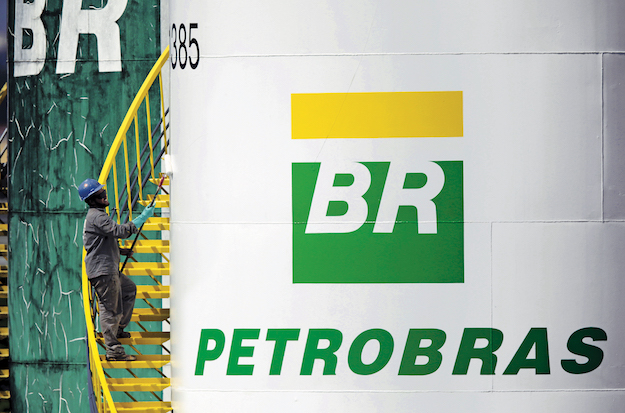This article is adapted from AQ’s print issue on peace and economic opportunity in Colombia | Leer en español | Ler em português
We’ve all read the headlines: Petrobras, Brazil’s state-run oil company, has in recent years become a byword for dysfunction and corruption, the epicenter of the so-called Car Wash scandal that saw at least $5 billion pilfered from its coffers.
So – how on earth did Brazil recently surpass both Venezuela and Mexico to become Latin America’s top producer of crude oil, and the 10th-largest in the world?
The answer lies in the company’s accumulated victories since the late 1990s, the recent struggles of Petrobras’ regional peers, a dramatic management turnaround over the past year – and perhaps a bit of luck. The bottom line: It turns out the Workers’ Party didn’t completely wreck the company after all.
A history of ups and downs
Petrobras’ volatile history goes back to 1953, when the company was founded by then-Brazilian President Getúlio Vargas. This came well after state oil companies were created in Argentina, Bolivia and Mexico, and during a post-World War II boom that saw a significant rise in global demand for oil. For the next four decades, the Brazilian constitution forbade foreign oil companies from operating in the country, giving Petrobras a monopoly.
In 1997, President Fernando Henrique Cardoso (1995–2003) managed to win enough votes in Congress to change this. At the time, Brazil produced 1 million barrels of oil a day – compared to Mexico’s 3 million, and Venezuela’s 3.5 million – and still needed to import oil to meet local demand. Cardoso argued that opening up the sector would not only make Brazil self-sufficient in energy, but would, over time, transform the country into an energy powerhouse.
Cardoso’s plan worked. Foreign capital flowed in, investment in exploration increased, and multinational oil companies spread around the sort of technology and know-how needed to locate and extract tricky undersea reserves. In 2006, under Workers’ Party President Luiz Inácio Lula da Silva (2003–2010), Petrobras and its new partners BG and Galp Energía announced the discovery of a giant offshore deposit in an area deep beneath a layer of salt at the bottom of the Atlantic Ocean.
It was the biggest oil find in the Western Hemisphere in many decades. The entire “sub-salt extension,” it was estimated, could hold up to 50 billion barrels – or $2.5 trillion worth of oil at current prices. In announcing the find, Lula declared that “God is Brazilian,” reflecting the euphoria of a heady decade for Brazil.
The oil was still years away from being extracted, but Brazil’s leaders immediately began making plans for what to do with the cash. Petrobras Chairwoman Dilma Rousseff, who would later serve as president of Brazil from 2011 to 2016, declared the sub-salt riches the key to vast education and social programs that would pull millions out of poverty and drive Brazil further down a path to modernity. In 2010, Petrobras launched one of the biggest share issues in history, raising $70 billion to finance the extraction of the sub-salt.
Shortly afterward, Petrobras began its spectacular collapse. Much of it could be attributed to the corruption and mismanagement that often occurs in resource-rich countries, as memorably described by Princeton professor Michael Ross in his book The Oil Curse. The company was turned into a cash machine for financing several political parties, while from 2011 to 2014 Petrobras spent an estimated $40 billion to subsidize fuel imports so that gas prices could stay artificially cheap for Brazilians at the pumps. Then, starting in mid-2014, oil prices collapsed. Damaged further by the eruption of the Car Wash scandal, the company’s net debt rose to an extraordinary $128 billion by the end of 2014.
The wreckage spread far and wide. Several former Petrobras executives have been sent to jail in connection with the scheme, Rousseff was impeached, Lula was accused of corruption and sentenced to prison time, and house speaker Eduardo Cunha was thrown behind bars for receiving kickbacks. Meanwhile, Petrobras – and Brazil’s economy in general – spiraled deeper into the abyss. Petrobras reported losses in three straight years from 2014 to 2016, including a worst-ever full-year loss of nearly $10 billion in 2015.
The latest comeback
That’s the story everybody knows.
This year, Petrobras is back – in the first quarter, the state-run oil company reported a $1.4 billion profit, which it attributed to production gains, falling costs and higher exports. In June, the hydrocarbons agency ANP announced that sub-salt production outstripped all other production for the very first time.
One explanation is that the money stolen under Car Wash, while staggering, paled in comparison to the billions of dollars Petrobras invested in the sub-salt fields. A total investment figure is hard to find, but Petrobras said in a 2014 report that it had invested $24 billion from 2004 to 2013 in the deep-sea area. Projected investment in the sub-salt from 2014 to 2018 is close to $100 billion. It is fair to say that considerable credit still must go to the Lula and Rousseff governments for taking such a big gamble on the sub-salt and deciding to invest heavily in the area.
The turnaround also has to do with Petrobras’ new CEO, Pedro Parente, and the policies of Brazil’s president, Michel Temer, who appointed him. Parente was the government’s chief of staff from 1999 to 2002 under Cardoso, and helped draw up the legislation that opened Petrobras to competition and private investment. Later Parente would use his experience in the public sector to carve out a successful business career, including as CEO of the Brazilian arm of the agribusiness giant Bunge, where he is credited with turning around its fortunes.
Though Petrobras remains the world’s most leveraged oil company, with around $30 billion due in 2017 and 2018, the company is furiously offloading assets, and maintains that it will hit its 2017-18 divestment target of $21 billion.
Temer has also helped to woo back faith. Last November, he signed off on a bill that lifts restrictions on international exploration and production companies in sub-salt blocks. Temer has also overhauled local content rules, making it easier for oil companies to source cheaper equipment and services abroad.
In a recent conference call with investors, Petrobras said money was again pouring in.
“All sources of funding, local and overseas, have opened again to us,” Chief Financial Officer Ivan Monteiro said.
Today, Brazil produces 2.7 million barrels of oil a day. That’s now good enough for first place in Latin America, partly given the struggles of Brazil’s peers. Going forward, the forecasts are even brighter. Brazil’s energy research agency EPE expects crude output to hit 5.2 million barrels a day in 2026, spurred by new production at the Libra, Búzios and Atapu fields off the southeast coast. That could make Brazil the fourth-largest producer on the globe, behind the United States, Saudi Arabia and Russia.
After two years of inactivity, Brazil is now preparing for its busiest bidding period since the late 1990s. Four auctions will be held this year, followed by another six in 2018 and 2019. Meanwhile, oil prices are starting to rise.
So the question is, how does the country avoid the failures of the recent past?
Ross argues that the way to fight the oil curse is by altering the size, source and secrecy of the business. One way to do this is to minimize the power and reach of Petrobras. The state-run company seems to do best when private-sector practices are embraced as much as possible. Recent loosening of local content rules and mandatory Petrobras requirements in sub-salt fields can also be considered positive in this respect. If one takes a long-term view, against all odds, things seem to be moving in the right direction for Petrobras.






